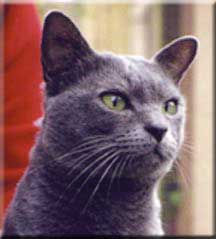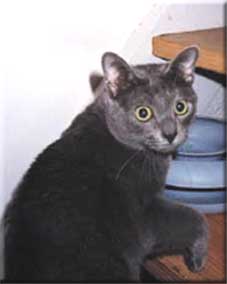 Primprau's
Starcrossed Chance
Primprau's
Starcrossed ChanceAbout
importing a cat to UK
... without quarantine!
For many years it has been possible to import cats and dogs to UK, if the animals were put through 6 months quarantine. Not all quarantine stations are very good - several animals are known to have died in quarantine. Other places are excellent, but quarantine is always stressful for the animal, and a financial burden for the importer. Therefore the number of pedigree animals leaving UK for breeders in other European countries has always been very much greater than any entering.
In 1992 things changed - at least for commercially traded animals from EU countries - that is to say for animals going from a European breeder to their counterpart in UK. These "new" rules are known as 'The Balai Directive'. This was written 1992, and has been in effective use since 1994, but knowledge of it and its operation is still limited - even in UK.
 Primprau's
Starcrossed Chance
Primprau's
Starcrossed Chance
I will try to describe what I did when my young male cat suddenly was destined for UK. I only mention cats and catteries, but almost the same rules go for dogs and kennels.
These are the Balai regulations, taken directly from a MAFF publication:
Requirements
for bringing a commercially traded dog or cat into the United Kingdom
Commercially traded dogs and cats may be imported from any other Member State
of the European Union into the UK without quarantine, if they comply with all
the strict criteria listed below.
(Note - for imports from the Republic of Ireland, please see penultimate paragraph
of this letter.)
Dogs and Cats:
NB! This means that no animal may be imported until six months after a vaccination which has been proved to be effective by a satisfactory blood test result.
These rules may seem complicated and troublesome at first, but they just mean organising some paperwork.One of the main problems is that not many in UK know The Balai Directive, or how to put it into operation so it can be difficult to know how things stand.
The decision about sending a cat to UK has been taken.
Now a series of practical steps must be taken:
 Primprau's
Starcrossed Chance
Primprau's
Starcrossed Chance
In my case the cat was older and 90 days had already passed since the first rabies vaccination. He had to have a second rabies vaccination. The big question then was whether the six months would be counted from the date of the first vaccination or the second. All those in UK reading the document for the first time, the importer and even the duty vet in MAFF believed that the note in bold type made it clear that it would be from the vaccination for which the test was done (the second one). However, the MAFF Administration Officer responsible for this import had initially said it would be the first vaccination, and it was confirmed that it was her knowledge that was most up to date. Apparently, there had been a legal ruling on this very point in UK only a short time ago. The main part of the text is of more importance than the note, and the second vaccination is viewed in the same way as a booster. As long as least six months had elapsed since the primary vaccination and the titer test was satisfactory, he could leave for the UK as soon as the travel arrangements had been completed.
In the meantime, the cat may not leave the breeder's cattery unless to go to the vet for 6 months - this means it may not go to shows or run loose outside.
The controlling vet guarantees that these conditions have been observed by a signature.
Now it is time to consider the travel arrangements for the cat.
(I can only talk about travelling from Denmark to UK, as that is what I have experienced.)
If you fly directly from Copenhagen to UK, you must use a shipping company. ( It was the MAFF Officer's opinion that if you fly from Copenhagen to UK via another airport in Europe, the cat can travel as baggage in the cargo area of the plane, because then the airport of origin is not Copenhagen (if the animal is accompanied there is a big price difference - 1000DKK approx.) We were told that only Denmark insists on using a shipping firm, supposedly because of past experience with very high fines for allowing export of animals for illegal entry into UK. (At least this was the explanation of the MAFF Officer we dealt with, whose opinion was that Denmark was interpreting UK rules too rigorously. However, the exporter always must follow the procedures of the exporting country, who may interpret guidelines to its own standards.)
In the following I will describe what we did when the cat travelled directly from Copenhagen to UK
When the cat's date of entry approaches, British Airways must be contacted. BA is the only airline with permission to transport animals into UK. The cat must travel as cargo, handled by a shipping firm, and in the cargo area of the plane - no matter if the breeder or the importer is on the same plane or not.
BA must approve the carrier (Kennel Cab is ok) and that there is space for the cat on the particular flight you request (they only allow one animal per flight). The shipping company must also approve the carrier - they have wooden carriers, which they recommend and offer for DKK800. If you can convince them that you have your own carrier which BA will approve, then Kennel Cab is ok - otherwise the shipping company has their wooden carriers ready for you to buy.
BA's preferred shipping company in Copenhagen is allegedly Airland International (++45 32 51 86 00), just behind the airport. Airland International charge DKK1292 for their services of sending a cat to UK. This amount must be paid cash when delivering the cat 3 hours before departure. At this time all the original vaccination papers and the health certificate must be shown.
Other shipping companies might also be used, but BA Cargo in Copenhagen refer directly to Airland International. In order to be able to send the cat, Airland International (and most probably also any other shipping firm) need the following information:
Then everything should be ready for travel.
Once the cat gets into UK to importer's cattery, the cat must be isolated for about 10 days.
A quote from Balai about this point:
The DVM will examine all animals within 48 hours of arrival at the premises of destination in order to check the certification and this will necessitate being able to read the implanted microchip. The importer must provide the relevant reader. In addition, currently a blood sample is taken to prove the rabies antibody level is adequate to confirm vaccination. Whilst the results of this blood test are awaited the animal(s) must be kept at the original premises of destination. The animal must not be moved from those premises for 10 days or until the DVM has given clearance in writing.
It is the importer's responsibility to provide a scanner that can read the chip implanted in the imported cat. Make sure to have the newest scanner available at hand - the cat has probably been microchipped with the newest kind of chip. We ran into this problem at the end - a local vet had just recently bought a new scanner that could read the chip, the two scanners borrowed from a friend were incompatible with the chip even though the company stated they could read the brand of chip (INDEXEL).
Exporter:
Camilla Baird - Primprau's Korats, Denmark
Importer: Jen Lacey - Jenanca
Korats, Great Britain
